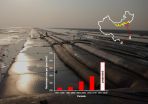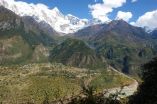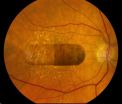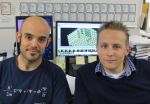China's new 'Great Wall' not so great
2014-11-20
(Press-News.org) China's second great wall, a vast seawall covering more than half of the country's mainland coastline, is a foundation for financial gain - and also a dyke holding a swelling rush of ecological woes.
A group of international sustainability scholars, including Jianguo "Jack" Liu, director of Michigan State University's Center for Systems Integration and Sustainability, in a paper published today in Science magazine, outline the sweeping downsides of one of China's efforts to fuel its booming economy, downsides that extend beyond China.
China's coastal regions are only 13 percent of the country's land area, but contribute 60 percent of its gross domestic product. With that come layers of incentives to turn lush wetlands into engines of development and industry.
Yet the scientists outline vast ecological costs that don't appear instantly on balance sheets. They note that the wetland ecosystems support a daunting number of birds, millions of which rely on the coastlines as they migrate. The coastlines produce 28 million tons of fishery products, nearly 20 percent of the world's total. Looking deeper reveals abundant biodiversity and a support system that also provides other invaluable but underappreciated services for people. For example, coastal wetlands absorb pollutants and carbon and protect people from extreme weather.
"These coastal areas are a perfect example of coupled human and natural systems. They are also a telling example of how telecoupled our world is," said Liu, who holds the Rachel Carson Chair in Sustainability at MSU. "The decisions being made in China are having enormous consequences to people and ecosystem services in China and the rest of the world. We must bring ecosystem services to the business table for a sustainable future."
The authors note that while there are laws aimed at protecting coastal wetlands, they lack teeth, and are inadequate in face of the immediate profits.
INFORMATION:
"Rethinking China's new great wall" was written, in addition to Liu, by Zhijun Ma, Ying Chen and Bo Li of Fudan University in Shanghai; David Melville in New Zealand; Hongyan Yang of Beijing Forestry University and University of Groningen in The Netherlands; Wenwei Ren of the World Wildlife Fund in Shanghai; Zhengwang Zhang of Beijing Normal University; and Theunis Piersma of University of Groningen.
Liu's work was funded by the National Science Foundation.
[Attachments] See images for this press release:

ELSE PRESS RELEASES FROM THIS DATE:
2014-11-20
The Himalaya features some of the most impressive gorges on Earth that have been formed by rivers. The geologic history of the famous Tsangpo Gorge, in the eastern Himalaya, now needs to be rewritten.
A team of German, Chinese, and American geoscientists have namely discovered a canyon, filled with more than 500 m of sediments beneath the bed of the present-day Yarlung Tsangpo River upstream from the gorge. Using drill cores, the scientists were able to reconstruct the former valley floor of this river, which allowed them to reconstruct the geological history of the Tsangpo ...
2014-11-20
Doctors have long been mystified as to why HIV-1 rapidly sickens some individuals, while in others the virus has difficulties gaining a foothold. Now, a study of genetic variation in HIV-1 and in the cells it infects reported by University of Minnesota researchers in this week's issue of PLOS Genetics has uncovered a chink in HIV-1's armor that may, at least in part, explain the puzzling difference -- and potentially open the door to new treatments.
HIV-1 harms people by invading immune system cells known as T lymphocytes, hijacking their molecular machinery to make more ...
2014-11-20
A team of researchers from Caltech and the China Earthquake Administration has discovered an ancient, deep canyon buried along the Yarlung Tsangpo River in south Tibet, north of the eastern end of the Himalayas. The geologists say that the ancient canyon--thousands of feet deep in places--effectively rules out a popular model used to explain how the massive and picturesque gorges of the Himalayas became so steep, so fast.
"I was extremely surprised when my colleagues, Jing Liu-Zeng and Dirk Scherler, showed me the evidence for this canyon in southern Tibet," says Jean-Philippe ...
2014-11-20
Bangkok (Thailand)- A recent study from the Thai-Myanmar border highlights the severe and previously under-reported adverse impact of readily treatable tropical rickettsial illnesses, notably scrub typhus and murine typhus, on pregnancy outcomes, finding that more than one third of affected pregnancies resulted either in stillbirth or premature and/or low birth weight babies.
Conducted by Prof Rose McGready and Assoc. Prof Daniel Henry Paris from the Shoklo Malaria Research Unit (SMRU) in Mae Sot, Thailand, and the Mahidol Oxford Research Unit (MORU) in Bangkok, affiliated ...
2014-11-20
LEXINGTON, Ky. (Nov. 20, 2014) - A landmark study published today in the journal Science by an international group of scientists, led by the laboratory of Dr. Jayakrishna Ambati, professor & vice chair of the Department of Ophthalmology & Visual Sciences at the University of Kentucky, reports that HIV/AIDS drugs that have been used for the last 30 years could be repurposed to treat age-related macular degeneration (AMD), as well as other inflammatory disorders, because of a previously undiscovered intrinsic and inflammatory activity those drugs possess.
AMD is a progressive ...
2014-11-20
Scientists developed a new method which allows to estimate the magnetic field of a distant exoplanet, i.e., a planet, which is located outside the Solar system and orbits a different star. Moreover, they managed to estimate the value of the magnetic moment of the planet HD 209458b.The group of scientists including one of the researchers of the Lomonosov Moscow State University (Russia) published their article in the Science magazine.
In the two decades which passed since the discovery of the first planet outside the Solar system, astronomers have made a great progress ...
2014-11-20
MADISON, Wis. -- As real as that daydream may seem, its path through your brain runs opposite reality.
Aiming to discern discrete neural circuits, researchers at the University of Wisconsin-Madison have tracked electrical activity in the brains of people who alternately imagined scenes or watched videos.
"A really important problem in brain research is understanding how different parts of the brain are functionally connected. What areas are interacting? What is the direction of communication?" says Barry Van Veen, a UW-Madison professor of electrical and computer engineering. ...
2014-11-20
MADISON, Wis. - The influenza virus, like all viruses, is a hijacker. It quietly slips its way inside cells, steals the machinery inside to make more copies of itself, and then -- having multiplied -- bursts out of the cell to find others to infect.
Most drugs currently used to treat influenza are designed to attack the virus, to render it incapacitated. But influenza viruses are sneaky, capable of mutating to avoid destruction by the drug.
In a comprehensive new study published today in the journal Cell Host and Microbe, the University of Wisconsin-Madison's Yoshihiro ...
2014-11-20
EUGENE, Ore. -- Nov. 20, 2014 -- A potential path to identify imperfections and improve the quality of nanomaterials for use in next-generation solar cells has emerged from a collaboration of University of Oregon and industry researchers.
To increase light-harvesting efficiency of solar cells beyond silicon's limit of about 29 percent, manufacturers have used layers of chemically synthesized semiconductor nanocrystals. Properties of quantum dots that are produced are manipulated by controlling the synthetic process and surface chemical structure.
This process, however, ...
2014-11-20
CHAMPAIGN, Ill. -- The majority of preschoolers may not be getting the amount of sleep they need each night, placing them at higher risk of being overweight or obese within a year, according to a new study.
Published online by the journal Sleep Medicine, the study investigated links between mothers' employment status and their children's weight over time, exploring the impact of potential mediators, such as children's sleep and dietary habits, the amount of time they spent watching TV and family mealtime routines.
"The only factor of the four that we investigated that ...
LAST 30 PRESS RELEASES:
[Press-News.org] China's new 'Great Wall' not so great




